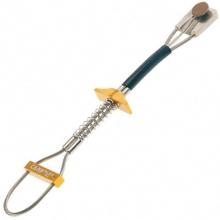Ball Nut 1
Description
• Rock Climbing, Aid Climbing
• The smallest active protection in the world
• Color-coded for fast identification
• Narrow depth fits shalllower cracks than traditional camming units
For the slim and grim. Invented in 1987 by John Middendorf and originally brought to market as Lowe Balls, these have become the secret weapon of many aid and trad climbers. These little wonders will work in small parallel-sided cracks where the only other option is pounding a piton. Ball Nuts also work in pin scars and small flares where cams simply won’t fit. Since they weigh so little, many advanced trad climbers keep a #2 and #3 on their rack at all times.
Retail price
When you click a link below and then checkout online, no matter what you buy (climbing gear or not), we get a small commission that helps us keep this site up-to-date. Thanks!
Weight (g / oz)  Weight (g / oz)In grams and ounces, the weight, as stated by the manufacturer/brand. | 31 g / 11.00 oz |
Size  SizeThe size according to the manufacturer/brand. |
1 |
Strength (kN)  Strength (kN)In kilonewtons, the strength as stated by the manufacturer/brand. |
8 kN |
Color  ColorThe main or identifying color of the device. |
Blue |
Range (in / mm)  Range (in / mm)In inches and millimeters, the maximum range as stated by the manufacturer/brand. | 0.12 in - 0.24 in 3.00 mm - 6.00 mm |
If you know of a good product video that should be here, let us know, and we'll put it up.
If you're looking for gear videos in general, check out our Vimeo and YouTube channels to see the newest gear.
The UIAA equipment standard provides a baseline for equipment performance in a test lab under controlled conditions on new equipment. Although these test conditions are relevant to the conditions encountered climbing, conditions encountered at the crags and the condition of the equipment are equally important. This recommendation from the UIAA member federation The British Mountaineering Council (BMC) provides vital equipment information that is NOT explicitly addressed in the standard, particularly failure modes of the equipment and recommendations for the use, inspection, maintenance, and retirement of equipment.
A pictoral representation of the UIAA-125 and EN-12276 standards for frictional anchors (which includes SLCD's [cams] and Ballnuts).






